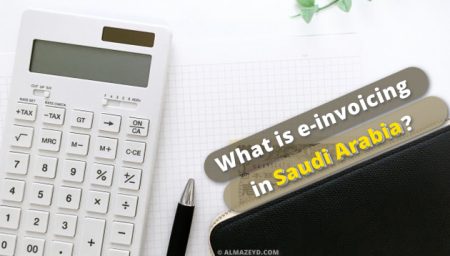
The Kingdom of Saudi Arabia (KSA) began to roll out new initiatives to digitise the economy. One such initiative was electronic invoices that could be used for VAT purposes. The Zakat, Tax and Customs Authority (ZATCA), earlier known as the General Authority of Zakat and Tax (GAZT), issued a draft amendment to introduce e-invoices in September 2020. The implementation of e-invoicing in Saudi Arabia was broken down into two phases, phase 1 (generation) and phase 2 (integration). Phase 1 was implemented in December 2021, and Phase 2 will commence in January 2023. Taxpayers can use e-invoicing software in Saudi Arabia to generate these invoices.
What is e-invoicing?
Also known as Fatoorah, an e-invoice is an electronic invoice that can be generated using e-invoicing software in Saudi Arabia. These aim to convert paper invoices into digital, electronic ones for easy tracking and submission. The entire e-invoicing process encompasses generating and processing accurate invoices, debit or credit notes and validating data in a structured manner. The electronic format makes it very easy for buyers and sellers to do so.
The regulations related to tax invoices in the Value Added Tax (VAT) legislation also apply to e-invoices. Non-compliance with the same can result in penalties issued by ZATCA. It is also important to note that provisions related to the proof of electronic transactions and electronic signatures as per the Electronic Transactions Law are also applicable to e-invoices and credit/debit notes.
Why ZATCA introduced e-invoicing in Saudi Arabia?
The idea behind e-invoices was to phase out hand-written invoices and create a digital economy. e-Invoicing was also seen as a tool that could help businesses function more efficiently. Accordingly, businesses must integrate their systems with ZATCA, ensuring better transparency. Invoices have become standardised in their formatting and the manner of submissions, making it more convenient for the government.
e-Invoices allow ZATCA to detect fraudulent activities, create a common database for audits, and ensure smooth functioning across industries. Tax authorities can also track the transactions in real time.
Who is responsible for implementing e-invoicing in Saudi Arabia?
ZATCA is responsible for implementing e-invoicing in Saudi Arabia. After consulting the public and various stakeholders, they released e-Invoicing Regulations on 28th May 2021.
According to these regulations, all resident taxpayers must be mandatorily fully equipped to issue, modify, and save e-invoices by 4th December 2021, when Phase 1 was scheduled. These regulations issued by ZATCA also specify the requirements, terms, and conditions to be met when creating and issuing electronic invoices and credit and debit notes. Additionally, ZATCA has also released a set of detailed guidelines on e-invoicing to ensure smooth implementation.
Applicability of e-invoicing in Saudi Arabi
It is mandatory for all entities registered under KSA VAT, third parties who issue invoices on behalf of any taxable individuals and customers to issue electronic invoices. The previously applicable VAT regulations related to tax invoices, credit and debit notes apply to e-invoices.
It is important to note that non-resident taxpayers under VAT are excluded from e-invoicing in Saudi Arabia.
What are the phases of e-invoicing?
e-Invoicing is being implemented in two phases to ensure ease of use and smooth operations. These are as follows:
Phase 1: Generation
The first phase is known as the ‘Generation Phase’. During this phase, taxpayers must generate and save tax invoices and simplified tax invoices, as well as the respective CDNs, via a complaint e-invoicing software in Saudi Arabia. This phase was implemented on 4th December 2021. The e-invoicing princess is mandatory for all taxpayers (apart from non-resident taxpayers) and any other people who issue tax invoices on behalf of suppliers subject to VAT.
At this point, the procedures of issuing e-invoices are quite similar to issuing invoices in the past. The only difference is that they must use a compatible electronic billing system. The e-invoice has to include all the required data based on the type of invoice, as per ZATCA Regulations.
Phase 2: Integration
The second phase is known as the ‘Integration Phase’. It will begin on 1st January 2023. ZATCA has announced that VAT taxpayers with a turnover higher than SAR 3 Billion must be aligned with this phase from 1st January 2023.
Businesses must integrate their accounting software/ERPs with ZATCA’s systems during this phase. Taxpayers shall generate invoices using complaint e-invoicing software to ‘clear’ the standard tax invoices and ‘report’ the simplified tax invoice.
Benefits of e-invoicing in Saudi Arabia
The following are some of the benefits of e-invoicing in Saudi Arabia:
- It ensures complete transparency in all commercial transactions
- It helps with effortless transactions and better accuracy
- It is environmentally friendly as it reduces the need for paper invoices
- It helps check the shadow economy by allowing government officials to weed out fake invoices
- It offers better standardisation, seamless trade, reduced costs, faster payments, and quicker communications.
Now that you know what electronic invoices are, you can start generating them as per your needs. Using e-invoicing software in Saudi Arabia is critical during phase 1, so you can easily generate ZATCA-compliant invoices.